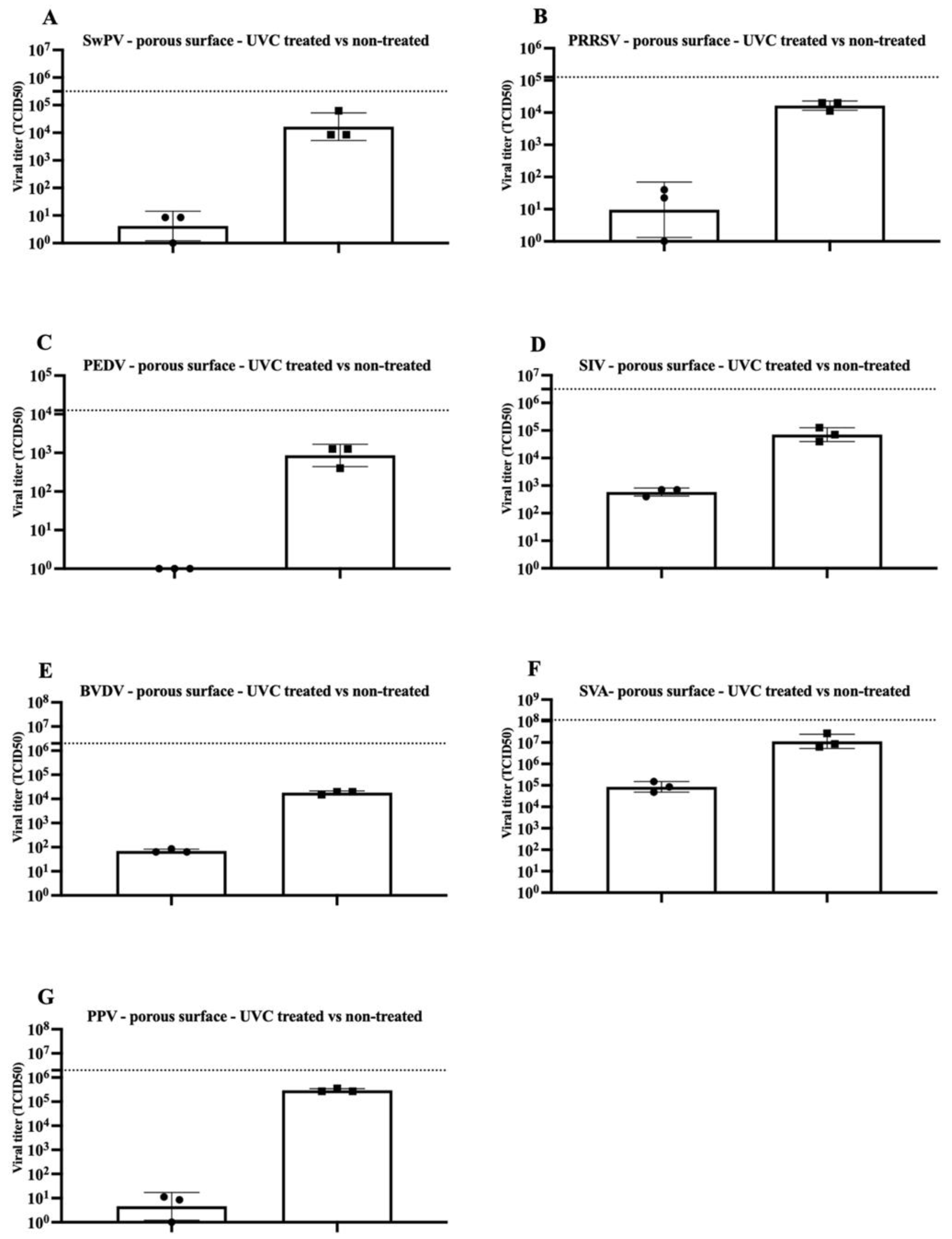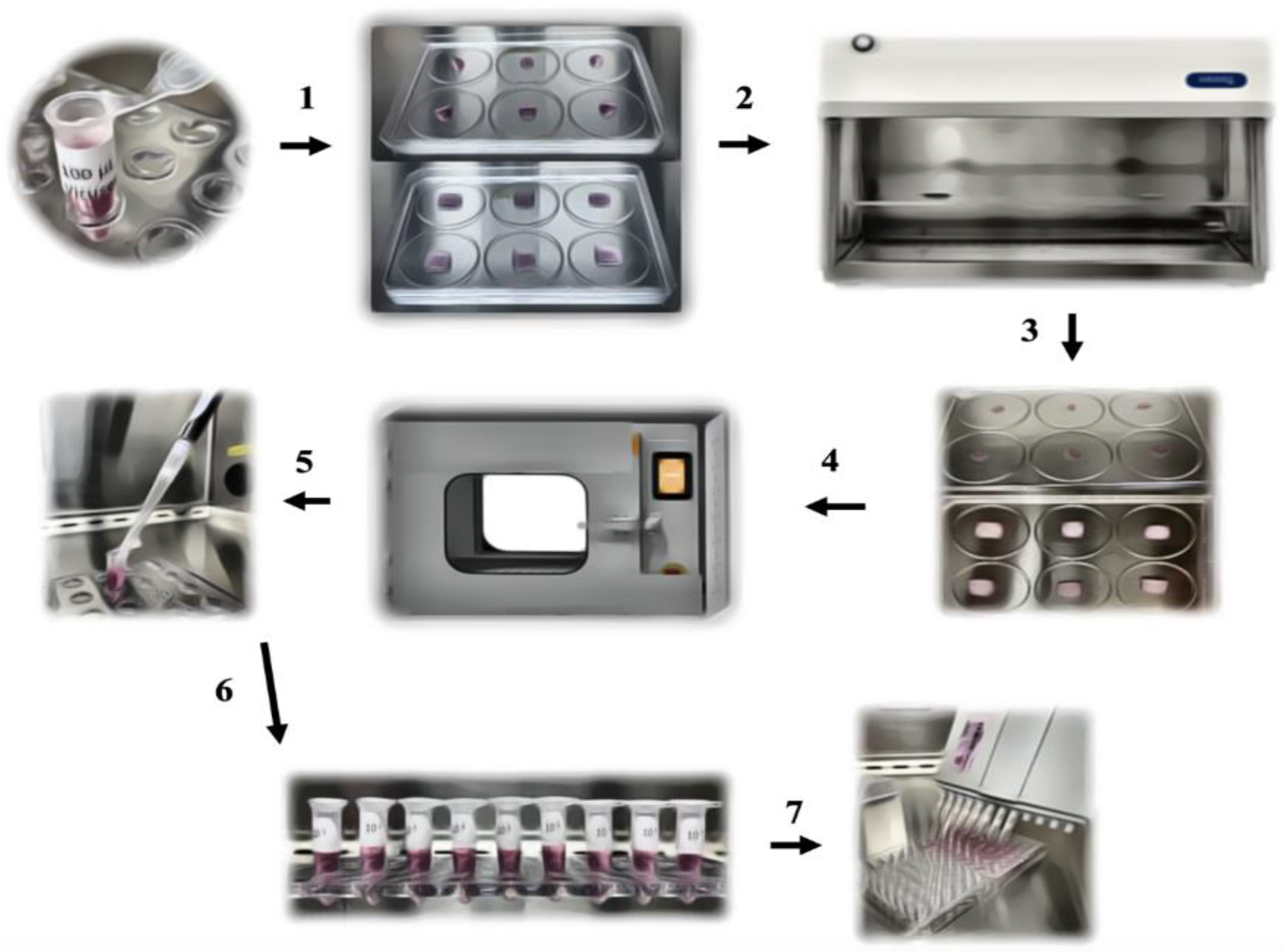Evaluation of Ultraviolet Type C Radiation in Inactivating Relevant Veterinary Viruses on Experimentally Contaminated Surfaces
Abstract
:1. Introduction
2. Results and Discussion
3. Materials and Methods
3.1. Viruses and Cells
3.2. Study Design
Author Contributions
Funding
Data Availability Statement
Acknowledgments
Conflicts of Interest
References
- Dee, S.; Otake, S.; Deen, J. An evaluation of ultraviolet light (UV254) as a means to inactivate porcine reproductive and respiratory syndrome virus on common farm surfaces and materials. Vet. Microbiol. 2011, 150, 96–99. [Google Scholar] [CrossRef] [PubMed]
- Ruston, C.; Zhang, J.; Scott, J.; Zhang, M.; Graham, K.; Linhares, D.; Breuer, M.; Karriker, L.; Holtkamp, D. Efficacy of ultraviolet C exposure for inactivating Senecavirus A on experimentally contaminated surfaces commonly found on swine farms. Vet. Microbiol. 2021, 256, 109040. [Google Scholar] [CrossRef] [PubMed]
- Abraham, G. The effect of ultraviolet radiation on the primary transcription of Influenza virus messenger RNAs. Virology 1979, 97, 6. [Google Scholar] [CrossRef]
- Rolfsmeier, M.L.; Laughery, M.F.; Haseltine, C.A. Repair of DNA Double-Strand Breaks following UV Damage in Three Sulfolobussolfataricus Strains. J. Bacteriol. 2010, 192, 4954–4962. [Google Scholar] [CrossRef] [PubMed] [Green Version]
- Nishisaka-Nonaka, R.; Mawatari, K.; Yamamoto, T.; Kojima, M.; Shimohata, T.; Uebanso, T.; Nakahashi, M.; Emoto, T.; Akutagawa, M.; Kinouchi, Y.; et al. Irradiation by ultraviolet light-emitting diodes inactivates influenza a viruses by inhibiting replication and transcription of viral RNA in host cells. J. Photochem. Photobiol. B Biol. 2018, 189, 193–200. [Google Scholar] [CrossRef] [PubMed]
- Azar Daryany, M.K.; Hosseini, S.M.; Raie, M.; Fakharie, J.; Zareh, A. Study on continuous (254 nm) and pulsed UV (266 and 355 nm) lights on BVD virus inactivation and its effects on biological properties of fetal bovine serum. J. Photochem. Photobiol. B Biol. 2009, 94, 120–124. [Google Scholar] [CrossRef] [PubMed]
- Cutler, T.D.; Wang, C.; Hoff, S.J.; Zimmerman, J.J. Effect of temperature and relative humidity on ultraviolet (UV254) inactivation of airborne porcine respiratory and reproductive syndrome virus. Vet. Microbiol. 2012, 159, 47–52. [Google Scholar] [CrossRef] [PubMed]
- Freitas, T.R.P.; Gaspar, L.P.; Caldas, L.A.; Silva, J.L.; Rebello, M.A. Inactivation of classical swine fever virus: Association of hydrostatic pressure and ultraviolet irradiation. J. Virol. Methods 2003, 108, 205–211. [Google Scholar] [CrossRef]
- Nuanualsuwan, S.; Thongtha, P.; Kamolsiripichaiporn, S.; Subharat, S. UV inactivation and model of UV inactivation of foot-and-mouth disease viruses in suspension. Int. J. Food Microbiol. 2008, 127, 84–90. [Google Scholar] [CrossRef] [PubMed]
- Li, P.; Koziel, J.A.; Zimmerman, J.J.; Zhang, J.; Cheng, T.-Y.; Yim-Im, W.; Jenks, W.S.; Lee, M.; Chen, B.; Hoff, S.J. Mitigation of Airborne PRRSV Transmission with UV Light Treatment: Proof-of-Concept. Agriculture 2021, 11, 259. [Google Scholar] [CrossRef]
- Blázquez, E.; Rodríguez, C.; Ródenas, J.; Navarro, N.; Riquelme, C.; Rosell, R.; Campbell, J.; Crenshaw, J.; Segalés, J.; Pujols, J.; et al. Evaluation of the effectiveness of the SurePure Turbulator ultraviolet-C irradiation equipment on inactivation of different enveloped and non-enveloped viruses inoculated in commercially collected liquid animal plasma. PLoS ONE 2019, 14, e0212332. [Google Scholar] [CrossRef] [PubMed] [Green Version]
- Blázquez, E.; Rodríguez, C.; Ródenas, J.; Navarro, N.; Rosell, R.; Pina-Pedrero, S.; Campbell, J.M.; Sibila, M.; Segalés, J.; Pujols, J.; et al. UV-C irradiation is able to inactivate pathogens found in commercially collected porcine plasma as demonstrated by swine bioassay. Vet. Microbiol. 2019, 239, 108450. [Google Scholar] [CrossRef] [PubMed]
- Cutler, T.; Wang, C.; Qin, Q.; Zhou, F.; Warren, K.; Yoon, K.-J.; Hoff, S.J.; Ridpath, J.; Zimmerman, J. Kinetics of UV254 inactivation of selected viral pathogens in a static system. J. Appl. Microbiol. 2011, 111, 389–395. [Google Scholar] [CrossRef] [PubMed] [Green Version]
- Rheinbaben, F.v.; Gebel, J.; Exner, M.; Schmidt, A. Environmental resistance, disinfection, and sterilization of poxviruses. In Poxviruses; Mercer, A.A., Schmidt, A., Weber, O., Eds.; Birkhäuser Basel: Basel, Switzerland, 2007; pp. 397–405. ISBN 978-3-7643-7557-7. [Google Scholar]
- Trakarnvanich, T.; Phumisantiphong, U.; Pupipatpab, S.; Setthabramote, C.; Seakow, B.; Porntheeraphat, S.; Maneerit, J.; Manomaipiboon, A. Impact of ultraviolet germicidal irradiation on new silicone half-piece elastometric respirator (VJR-NMU) performance, structural integrity and sterility during the COVID-19 pandemic. PLoS ONE 2021, 16, e0258245. [Google Scholar] [CrossRef] [PubMed]
- Tao, J.; Liao, J.; Wang, Y.; Zhang, X.; Wang, J.; Zhu, G. Bovine viral diarrhea virus (BVDV) infections in pigs. Vet. Microbiol. 2013, 165, 185–189. [Google Scholar] [CrossRef] [PubMed]
- Ebling, R.; Paim, W.P.; Turner, J.; Flory, G.; Seiger, J.; Whitcomb, C.; Remmenga, M.; Vuolo, M.; Ramachandran, A.; Cole, L.; et al. Virus viability in spiked swine bone marrow tissue during above-ground burial method and under in vitro conditions. Transbound. Emerg. Dis. 2022. [Google Scholar] [CrossRef] [PubMed]
- Depner, K.; Bauer, T.; Liess, B. Thermal and pH stability of pestiviruses. Rev. Sci. Tech. 1992, 11, 885–893. [Google Scholar] [CrossRef] [PubMed]
- Dee, S.A.; Bauermann, F.V.; Niederwerder, M.C.; Singrey, A.; Clement, T.; De Lima, M.; Long, C.; Patterson, G.; Sheahan, M.A.; Stoian, A.M.M.; et al. Survival of viral pathogens in animal feed ingredients under transboundary shipping models. PLoS ONE 2018, 13, e0194509. [Google Scholar] [CrossRef] [PubMed] [Green Version]
- Lackner, C.; Leydold, S.M.; Modrof, J.; Farcet, M.R.; Grillberger, L.; Schäfer, B.; Anderle, H.; Kreil, T.R. Reduction of spiked porcine circovirus during the manufacture of a Vero cell-derived vaccine. Vaccine 2014, 32, 2056–2061. [Google Scholar] [CrossRef] [PubMed]
- Reed, L.J.; Muench, H. A simple method of estimating fifty per cent endpoints. Am. J. Epidemiol. 1938, 27, 493–497. [Google Scholar] [CrossRef]



| Virus | Isolate ID | Viral Family | Envelope | Genetic Material 1 | Cell Line | Virus Stock Titer |
|---|---|---|---|---|---|---|
| SwPV | NADL | Poxviridae | Yes | dsDNA | PK15 | 105.5 TCID50/mL |
| PRRSV | NADL NA | Arteriviridae | Yes | (+)ssRNA | Marc-145 | 105.1 TCID50/mL |
| PEDV | Colorado 2013 | Coronaviridae | Yes | (+)ssRNA | Vero | 104.1 TCID50/mL |
| SIV | OK-Han1 | Orthomyxoviridae | Yes | (−)ssRNA | MDCK | 106.5 TCID50/mL |
| BVDV | Singer | Flaviviridae | Yes | (+)ssRNA | MDBK | 106.3 TCID50/mL |
| SVA | HI/2012-NADC40 | Picornaviridae | No | (+)ssRNA | ST | 108 TCID50/mL |
| PPV | Mengeling | Parvoviridae | No | ssDNA | ST | 106.3 TCID50/mL |
Publisher’s Note: MDPI stays neutral with regard to jurisdictional claims in published maps and institutional affiliations. |
© 2022 by the authors. Licensee MDPI, Basel, Switzerland. This article is an open access article distributed under the terms and conditions of the Creative Commons Attribution (CC BY) license (https://creativecommons.org/licenses/by/4.0/).
Share and Cite
Mendes Peter, C.; Pinto Paim, W.; Maggioli, M.F.; Ebling, R.C.; Glisson, K.; Donovan, T.; Vicosa Bauermann, F. Evaluation of Ultraviolet Type C Radiation in Inactivating Relevant Veterinary Viruses on Experimentally Contaminated Surfaces. Pathogens 2022, 11, 686. https://doi.org/10.3390/pathogens11060686
Mendes Peter C, Pinto Paim W, Maggioli MF, Ebling RC, Glisson K, Donovan T, Vicosa Bauermann F. Evaluation of Ultraviolet Type C Radiation in Inactivating Relevant Veterinary Viruses on Experimentally Contaminated Surfaces. Pathogens. 2022; 11(6):686. https://doi.org/10.3390/pathogens11060686
Chicago/Turabian StyleMendes Peter, Cristina, Willian Pinto Paim, Mayara Fernanda Maggioli, Rafael Costa Ebling, Kylie Glisson, Tara Donovan, and Fernando Vicosa Bauermann. 2022. "Evaluation of Ultraviolet Type C Radiation in Inactivating Relevant Veterinary Viruses on Experimentally Contaminated Surfaces" Pathogens 11, no. 6: 686. https://doi.org/10.3390/pathogens11060686
APA StyleMendes Peter, C., Pinto Paim, W., Maggioli, M. F., Ebling, R. C., Glisson, K., Donovan, T., & Vicosa Bauermann, F. (2022). Evaluation of Ultraviolet Type C Radiation in Inactivating Relevant Veterinary Viruses on Experimentally Contaminated Surfaces. Pathogens, 11(6), 686. https://doi.org/10.3390/pathogens11060686






